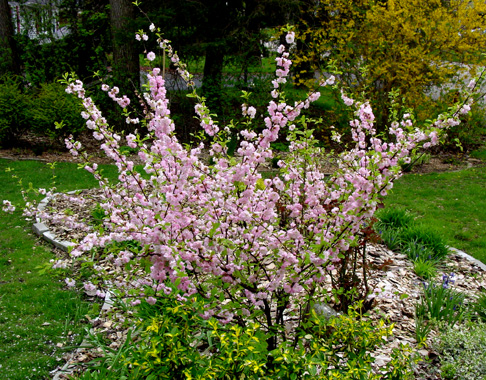A few years ago, while looking through one of the plant catalogs I receive each spring, I fell in love with a Flowering Almond shrub. I ordered the plant and it arrived in a few days as bare root stock. Following directions, I placed it in a bucket of water to rehydrate. The next day I planted my new shrub in a sunny spot our yard. Each year since that it has bloomed beautifully.
However, for the last two years, when it is almost finished blooming, a weird thing happens. It sort of dies back with a lot of dead branches. Both years I cut off the dead sections and it seemed to rebound and by the end of summer it looked good again.
After the second time this happened, I started reading about plant diseases, determined to fix the problem. After a bit of research, I found that my shrub apparently had been attacked by fire blight, a disease common to a lot of shrubby plants. That being said, I have a lot of the plants in our yard that are susceptible according to the fireblight list and since my flowering almond is the only one that has problems at the moment, I am seriously considering removing it before the disease spreads. It is truly a shame because the shrub is so beautiful when it blooms in spring.
Fireblight Research:
Fireblight is a widespread disease caused by bacteria. It attacks blossoms, leaves, shoots, branches, fruits, and roots.
Susceptible Plants:
The disease affects plants in the Rosaceae family, which includes trees and shrubs in orchards, nurseries and landscape plantings. The plants affected include Amelanchier (serviceberry), Chaenomeles (flowering quince), Cotoneaster (cotoneaster), Crataegus (hawthorn), Eriobotrya (loquat), Malus (apple and crabapple), Photinia (photinia), Prunus (flowering almond, plum and cherry), Pyracantha (pyracantha), Pyrus (pear), Rosa (rose), and Spirea (spirea).
Disease Cycle:
Initially the disease often enters the tree through natural openings, especially flowers and wounds in the spring. Once established in the tree, fireblight quickly invades through the current season’s growth into older growth. Fireblight can be spread from diseased to healthy plants by rain, wind, and pruning tools.
Disease Control:
To control fireblight prune out infected branches 8 inches below the damage. Avoid pruning when the plants are wet. Dip pruning tools in 70 percent isopropyl alcohol (rubbing alcohol) or 10 percent bleach solution (1 part bleach to 9 parts water solution) between each cut. Wash and oil shears when you are finished to avoid spreading the pathogen.
Avoid heavy nitrogen fertilization and splashing water. Chemical control is not always effective and needs to be applied preventively. Therefore, in years when warm, humid, wet weather coincides with flowering and leaf emergence, spray plants with a fungicide containing basic copper sulfate (Kocide) or an antibiotic (Agrimycin) to reduce infection. Re-application following rain may be needed.
Best Solution:
These preventive measures can help control fireblight, but all of the experts suggest simply planting varieties that are resistant.





What zone is this shrub???
It is listed as hardy in zones 4-8, so you could grow this one.
I have always had this shrub. It is one of my favorites, but it occasionally does this. I think that it has a tendency to behave like this. It doesn’t ever seem to affect any other plant in my garden. It is just one of it’s idiosyncracies. I basically ignore it.